Lockheed P-38 Lightning Video - Pilot Training Film - Flight Characteristics
More P-38 Lightning Videos 1 2 3 4 5 6 7 8 9 10 11 12 13 14 15 16 17 18 - Lockheed P-38 Lightning Pictures
|
|
|
|
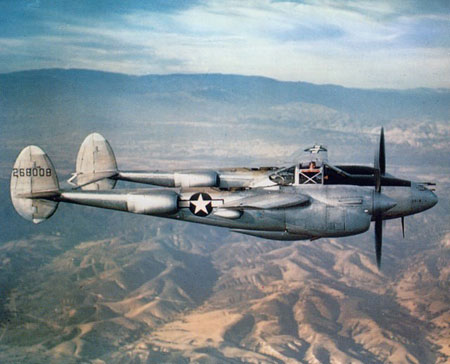
Ode To The P-38 Oh, Hedy Lamarr is a beautiful gal, and Madeleine Carroll is too, Yes, in the days that have passed, Byron, Shelley and Keats ran a dozen dead heats — Frederic Arnold Quote, 'Kohn's War' |
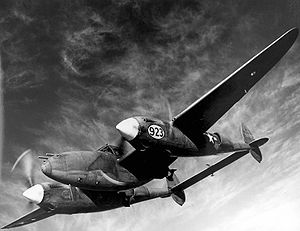 (Image:
P-38H-5-LO, AAF Ser. No. 42-66923, of the AAF Tactical Center, Orlando Army Air Base, Florida, carrying two 1,000 lb bombs during capability tests,
March 1944)
(Image:
P-38H-5-LO, AAF Ser. No. 42-66923, of the AAF Tactical Center, Orlando Army Air Base, Florida, carrying two 1,000 lb bombs during capability tests,
March 1944)
The Lockheed P-38 Lightning was a World War II American fighter aircraft. Developed to a United States Army Air Corps requirement, the P-38 had distinctive twin booms and a single, central nacelle containing the cockpit and armament. The aircraft was used in a number of different roles, including dive bombing, level bombing, ground strafing, photo reconnaissance missions, and extensively as a long-range escort fighter when equipped with droppable fuel tanks under its wings. The P-38 was used most extensively and successfully in the Pacific Theater of Operations and the China-Burma-India Theater of Operations, where it was flown by the American pilots with the highest number of aerial victories to this date. America's top ace Richard Bong earned 40 victories (in a Lightning he called Marge), and Thomas McGuire (in Pudgy) scored 38. In the South West Pacific theater, it was a primary long-range fighter of United States Army Air Forces until the appearance of large numbers of P-51D Mustangs toward the end of the war.
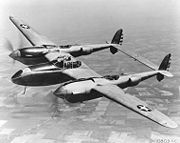 (Image:
Lockheed YP-38 (1943), one of 13 constructed)
(Image:
Lockheed YP-38 (1943), one of 13 constructed)
The P-38 was the only American fighter aircraft in active production throughout the duration of American involvement in the war, from Pearl Harbor to VJ Day.
Design and development
Lockheed designed the P-38 in response to the 1937 United States Army Air Corps Circular Proposal X-608, a request for a high-altitude interceptor aircraft having "the tactical mission of interception and attack of hostile aircraft at high altitude." Specifications called for a maximum airspeed of at least 360 miles per hour (580 km/h) at altitude, and a climb to 20,000 feet (6100 m) within six minutes; the toughest set of specifications USAAC had presented to that date. The Bell P-39 Airacobra and the Curtiss P-40 Warhawk were designed to the same requirement, as was the unbuilt Vultee XP1015.
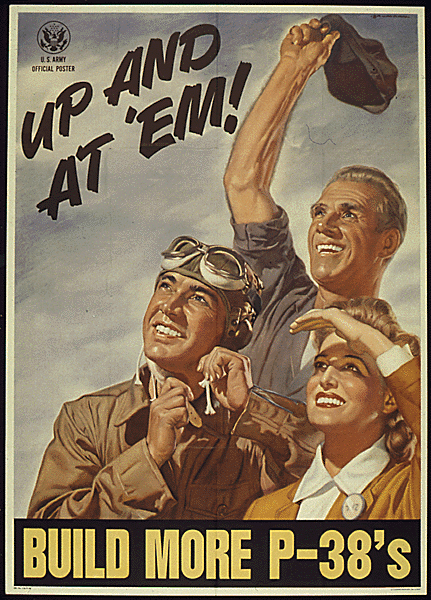 The Lockheed design team, under the direction of Hall Hibbard and “Kelly” Johnson, considered a range of configurations. All options considered by Lockheed were twin-engined, as it was judged that no single engine available at the time was powerful enough to meet the USAAC's requirements. (Engine development during World War II subsequently saw an approximate doubling of fighter engine horsepower, allowing many later single engine designs to achieve 400+ mph.)
The Lockheed design team, under the direction of Hall Hibbard and “Kelly” Johnson, considered a range of configurations. All options considered by Lockheed were twin-engined, as it was judged that no single engine available at the time was powerful enough to meet the USAAC's requirements. (Engine development during World War II subsequently saw an approximate doubling of fighter engine horsepower, allowing many later single engine designs to achieve 400+ mph.)
The eventual design was relatively unique in comparison to existing fighter aircraft, with only the Fokker G.1 and later Northrop P-61 Black Widow having a similar planform. The Lockheed team chose twin booms to accommodate the tail assembly, engines, and turbo superchargers, with a central nacelle for the pilot and armament. The nose was designed to carry two Browning .50" (12.7 mm) machine guns, with 200 rounds per gun, two .30" (7.62 mm) Brownings, with 500 rounds per gun, and an Oldsmobile 37 mm cannon with 15 rounds. Clustering all the armament in the nose was unlike most other U.S. aircraft, which used wing-mounted guns, and the trajectories were set up to crisscross at one or more points in a "convergence zone." The nose-mounted guns did not suffer from having their useful ranges limited by pattern convergence, meaning good pilots could shoot much farther. A Lightning could reliably hit targets at any range up to 1,000 yards (910 m), whereas other fighters had to pick a single convergence range between 100 and 250 yards (230 m). The clustered weapons had a "buzz saw" effect on any target at the receiving end, making the aircraft effective for strafing as well.
The Lockheed design incorporated tricycle undercarriage and a bubble canopy, and featured two 1000 hp (746 kW) turbo-supercharged 12-cylinder Allison V-1710 engines fitted with counter-rotating propellers to eliminate the effect of engine torque, with the superchargers positioned behind the engines in the booms. It was the first American fighter to make extensive use of stainless steel and smooth, flush-riveted butt-jointed aluminum skin panels. It was also the first fighter to fly faster than 400 mph (640 km/h).
Lockheed won the competition on 23 June 1937 with its Model 22, and was contracted to build a prototype XP-38 for US$163,000, though Lockheed's own costs on the prototype would add up to US$761,000. Construction began in July 1938 and the XP-38 first flew on 27 January 1939. The 11 February 1939 flight to relocate the aircraft for testing at Wright Field was extended by General Henry "Hap" Arnold, commander of the USAAC, to demonstrate the performance of the aircraft. It set a cross-continent speed record by flying from California to New York in seven hours and two minutes, but landed short of the Mitchel Field runway in Hempstead, New York, and was wrecked. However, on the basis of the record flight, the Air Corps ordered 13 YP-38s on 27 April 1939 for US$134,284 apiece. (The initial "Y" in "YP" was the USAAC's designation for a "prototype" while the "X" in "XP" was for "experimental".)
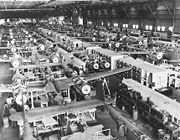 (Image:
Mechanized P-38 conveyor lines)
(Image:
Mechanized P-38 conveyor lines)
Manufacture of the YP-38s fell behind schedule, at least partly due to the need for mass-production suitability making them substantially different in construction than the prototype. Another factor was the sudden required facility expansion of Lockheed in Burbank, taking it from a specialized civilian firm dealing with small orders to a large government defense contractor making Venturas, Harpoons, Lodestars, Hudsons, and designing the Constellation airliner for TWA. The first YP-38 was not completed until September 1940, with its maiden flight on 17 September. The 13th and final YP-38 was delivered to the Air Corps in June 1941; 12 aircraft were retained for flight testing and one for destructive stress testing. The YPs were substantially redesigned and differed greatly in detail from the hand-built XP-38. They were lighter, included changes in engine fit, and the propeller rotation was reversed, with the blades rotating outwards (away) from the cockpit at the top of their arc rather than inwards as before. This improved the aircraft's stability as a gunnery platform.
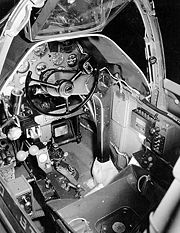 (Image:
Cockpit view of a P-38G. Note the yoke, rather than the more-usual stick)
(Image:
Cockpit view of a P-38G. Note the yoke, rather than the more-usual stick)
Test flights revealed problems initially believed to be tail flutter. During high-speed flight approaching Mach 0.68, especially during dives, the aircraft's tail would begin to shake violently and the nose would tuck under, steepening the dive. Once caught in this dive, the fighter would enter a high-speed compressibility stall and the controls would lock up, leaving the pilot no option but to bail out (if possible) or remain with the aircraft until it got down to denser air, where he might have a chance to pull out. During a test flight in May 1941, USAAC Major Signa Gilkey managed to stay with a YP-38 in a compressibility lockup, riding it out until he recovered gradually using elevator trim. Lockheed engineers were very concerned at this limitation, but first they had to concentrate on filling the current order of aircraft. Sixty-five Lightnings were finished by September 1941, and more were on the way.
By November 1941, many of the initial assembly line challenges had been met and there was some breathing room for the engineering team to tackle the problem of frozen controls in a dive. Lockheed had a few ideas for tests that would help them find an answer. The first solution tried was the fitting of spring-loaded servo tabs on the elevator trailing edge; tabs that were designed to aid the pilot when control yoke forces rose over 30 pounds, as would be expected in a high-speed dive. At that point, the tabs would begin to multiply the effort of the pilot's actions. The expert test pilot, 43-year-old Ralph Virden, was given a specific high-altitude test sequence to follow, and was told to restrict his speed and fast maneuvering in denser air at low altitudes since the new mechanism could exert tremendous leverage under those conditions. A note was taped to the instrument panel of the prototype, underscoring this instruction. On 4 November 1941, Virden climbed into YP-38 #1 and completed the test sequence successfully, but 15 minutes later was seen in a steep dive followed by a high-G pullout. The tail unit of the aircraft failed at about 3,000 ft (910 m) during the high-speed dive recovery; Virden was killed in the subsequent crash. The Lockheed design office was justifiably upset, but their design engineers could only conclude that servo tabs were not the solution for loss of control in a dive. Lockheed still had to find the problem; the Army Air Corps was sure it was flutter, and ordered Lockheed to look more closely at the tail.
Although the P-38's empennage was completely skinned in aluminum (not fabric) and was quite rigid, in 1941, flutter was a familiar engineering problem related to a too-flexible tail. At no time did the P-38 suffer from true flutter. To prove a point, one elevator and its vertical stabilizers were skinned with metal 63% thicker than standard, but the increase in rigidity made no difference in vibration. Army Lt. Colonel Kenneth B. Wolfe (head of Army Production Engineering) asked Lockheed to try external mass balances above and below the elevator, though the P-38 already had large mass balances elegantly placed within each vertical stabilizer. Various configurations of external mass balances were equipped and dangerously steep test flights flown to document their performance. Explaining to Wolfe in Report No. 2414, Kelly Johnson wrote " ... the violence of the vibration was unchanged and the diving tendency was naturally the same for all conditions." The external mass balances did not help at all. Nonetheless, at Wolfe's insistence, the additional external balances were a feature of every P-38 built from then on.
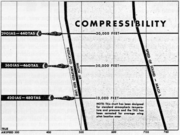 (Image:
P-38 pilot training manual compressibility chart shows speed limit vs. altitude)
(Image:
P-38 pilot training manual compressibility chart shows speed limit vs. altitude)
After months of pushing NACA to provide Mach 0.75 wind tunnel speeds (and finally succeeding), the compressibility problem was revealed to be the center of lift moving back toward the tail when in high-speed airflow. The compressibility problem was solved by changing the geometry of the wing's underside when diving so as to keep lift within bounds of the top of the wing. In February 1943, quick-acting dive flaps were tried and proven by Lockheed test pilots. The dive flaps were installed outboard of the engine nacelles and in action they extended downward 35° in 1½ seconds. The flaps did not act as a speed brake, they affected the center of pressure distribution so that the wing would not lose its lift. Late in 1943, a few hundred dive flap field modification kits were assembled to give North African, European and Pacific P-38s a chance to withstand compressibility and expand their combat tactics. Unfortunately, these crucial flaps did not always reach their destination. In March 1944, 200 dive flap kits intended for ETO P-38Js were destroyed in a mistaken identification incident in which an RAF fighter shot down the Douglas C-54 Skymaster bringing the shipment to England. Back in Burbank, P-38Js coming off the assembly line in spring 1944 were towed out to the tarmac and modified in the open air. The flaps were finally incorporated into the production line in June 1944 on the last 210 P-38Js. The delay in bringing the dive flap and its freedom of tactical maneuver to the fighting pilot was far too lengthy. Of all Lightnings built, only the final 50% would have the dive flaps installed as an assembly line sequence.
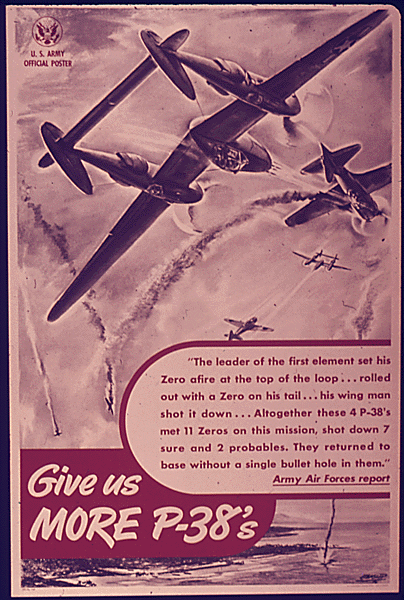 Johnson later recalled:
Johnson later recalled:
“ I broke an ulcer over compressibility on the P-38 because we flew into a speed range where no one had ever been before, and we had difficulty convincing people that it wasn't the funny-looking airplane itself, but a fundamental physical problem. We found out what happened when the Lightning shed its tail and we worked during the whole war to get 15 more knots [28 km/h] of speed out of the P-38. We saw compressibility as a brick wall for a long time. Then we learned how to get through it.”
Buffeting was another early aerodynamic problem, difficult to sort out from compressibility as both were reported by test pilots as "tail shake". Buffeting came about from airflow disturbances ahead of the tail; the airplane would shake at high speed. Leading edge wing slots were tried as were combinations of filleting between the wing, cockpit and engine nacelles. Air tunnel test number 15 solved the buffeting completely and its fillet solution was fitted to every subsequent P-38 airframe. Fillet kits were sent out to every squadron flying Lightnings. The problem was traced to a 40% increase in air speed at the wing-fuselage junction where the chord/thickness ratio was highest. An airspeed of 500 mph (800 km/h) at 25,000 ft (7,600 m) could push airflow at the wing-fuselage junction close to the speed of sound. Filleting forever solved the buffeting problem for the P-38E and later models.
Another issue with the P-38 arose from its unique design feature of outwardly rotating counter-rotating propellers. Losing one of two engines in any twin engine non-centerline thrust aircraft on takeoff creates sudden drag, yawing the nose toward the dead engine and rolling the wingtip down on the side of the dead engine. Normal training in flying twin-engine aircraft when losing an engine on takeoff would be to push the remaining engine to full throttle; if a pilot did that in the P-38, regardless of which engine had failed, the resulting engine torque and p-factor force produced a sudden uncontrollable yawing roll and the aircraft would flip over and slam into the ground. Eventually, procedures were taught to allow a pilot to deal with the situation by reducing power on the running engine, feathering the prop on the dead engine, and then increasing power gradually until the aircraft was in stable flight. Single-engine takeoffs were possible, though not with a maximum combat load.
The engine sounds were a unique, rather quiet "whuffle", because the exhausts were muffled by the General Electric turbosuperchargers on the twin Allison V12s. There were early problems with cockpit temperature regulation; pilots were often too hot in the tropic sun as the canopy could not be fully opened without severe buffeting, and were often too cold in northern Europe and at high altitude, as the distance of the engines from the cockpit prevented easy heat transfer. Later variants received modifications (such as electrically-heated flight suits) to solve these problems.
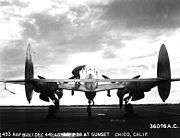 On 20 September 1939, before the YP-38s had been built and flight tested, the USAAF ordered 66 initial production P-38 Lightnings, 30 of which
were delivered to the USAAF in mid-1941, but not all these aircraft were armed. The unarmed aircraft were subsequently fitted with four .50s (instead
of the two .50 and two .30 of their predecessors) and a 37 mm cannon. They also had armor glass, cockpit armor and fluorescent cockpit controls.
One was completed with a pressurized cabin on an experimental basis and designated XP-38A. Due to reports the USAAF was receiving from Europe,
the remaining 36 in the batch were upgraded with small improvements such as self-sealing fuel tanks and enhanced armor protection to make them
combat-capable. The USAAF specified that these 36 aircraft were to be designated P-38D. As a result, there never were any P-38Bs or P-38Cs. The
P-38D's main role was to work out bugs and give the USAAF experience with handling the type.
On 20 September 1939, before the YP-38s had been built and flight tested, the USAAF ordered 66 initial production P-38 Lightnings, 30 of which
were delivered to the USAAF in mid-1941, but not all these aircraft were armed. The unarmed aircraft were subsequently fitted with four .50s (instead
of the two .50 and two .30 of their predecessors) and a 37 mm cannon. They also had armor glass, cockpit armor and fluorescent cockpit controls.
One was completed with a pressurized cabin on an experimental basis and designated XP-38A. Due to reports the USAAF was receiving from Europe,
the remaining 36 in the batch were upgraded with small improvements such as self-sealing fuel tanks and enhanced armor protection to make them
combat-capable. The USAAF specified that these 36 aircraft were to be designated P-38D. As a result, there never were any P-38Bs or P-38Cs. The
P-38D's main role was to work out bugs and give the USAAF experience with handling the type.
In March 1940, the French and the British ordered a total of 667 P-38s, designated Model 322F for the French and Model 322B for the British. The aircraft would be a variant of the P-38E, without turbo-supercharging (due to a U.S. government export prohibition), and twin right-handed engines instead of counter-rotating, for commonality with the large numbers of Curtiss P-40 Tomahawks both nations had on order. After the fall of France in June 1940, the British took over the entire order and re-christened the plane Lightning I. Three were delivered in March 1942 and, after discovering, without superchargers, at low altitude and when using lower-octane British aircraft fuel, they had a maximum speed of 300 miles per hour (480 km/h) and poor handling characteristics, the entire order was canceled. The remaining 140 Lightning I's were completed for the USAAF with counter-rotating engines but still minus turbo-superchargers. Most were relegated to United States Army Air Forces training units under the designation RP-322. These aircraft helped the USAAF train new pilots to fly a powerful and complex new fighter. A few Model 322 aircraft were later used as test modification platforms such as for smoke-laying canisters and dual air-dropped torpedoes. The RP-322 was a fairly fast aircraft (some of the fastest post-war racing P-38s were virtually identical in layout to the P-322-II) at low altitude and well suited as a trainer. The other positive result of the failed British/French order was to give the aircraft its name. Lockheed had originally dubbed the aircraft Atalanta in the company tradition of naming planes after mythological and celestial figures, but the RAF name won out.
Operational service
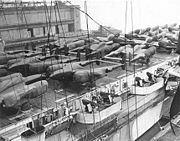 (Image:
P-38s deck-loaded on CVE, ready for shipment, cocooned against salt, at New York)
(Image:
P-38s deck-loaded on CVE, ready for shipment, cocooned against salt, at New York)
The first unit to receive P-38s was the 1st Fighter Group. After the attack on Pearl Harbor, the unit joined the 14th Pursuit Group in San Diego to provide West Coast defense.
Entry to the war
The first Lightning to see active service was the F-4 version, a P-38E in which the guns were replaced by four K17 cameras. They joined the 8th Photographic Squadron out of Australia on 4 April 1942. Three F-4s were operated by the Royal Australian Air Force in this theater for a short period beginning in September 1942.
On 29 May 1942, 25 P-38s began operating in the Aleutian Islands in Alaska. The fighter's long range made it well-suited to the campaign over the almost 1,200 mile (2,000 km)–long island chain, and it would be flown there for the rest of the war. The Aleutians were one of the most rugged environments available for testing the new aircraft under combat conditions. More Lightnings were lost due to severe weather and other conditions than enemy action, and there were cases where Lightning pilots, mesmerized by flying for hours over gray seas under gray skies, simply flew into the water. On 9 August 1942, two P-38Es of the 343rd Fighter Group, Eleventh Air Force, at the end of a 1,000 mile (1,600 km) long-range patrol, happened upon a pair of Japanese Kawanishi H6K "Mavis" flying boats and destroyed them, making them the first Japanese aircraft to be shot down by Lightnings.
European theater
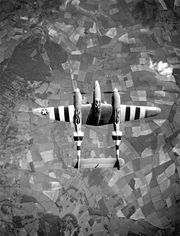 (Image:
P-38 participating in the Normandy campaign as evidenced by the D-Day invasion stripes)
(Image:
P-38 participating in the Normandy campaign as evidenced by the D-Day invasion stripes)
After the Battle of Midway, the USAAF began redeploying fighter groups to Britain as part of Operation Bolero, and Lightnings of the 1st Fighter Group were flown across the Atlantic via Iceland. On 14 August, 2nd Lieutenant Elza Shahan of the 27th Fighter Squadron, and 2nd Lieutenant Joseph Shaffer of the 33rd Squadron operating out of Iceland shot down a Focke-Wulf Fw 200 Condor over the Atlantic. Shahan in his P-38F downed the Condor; Shaffer, flying either a P-40C or a P-39, had already set an engine on fire. This was the first Luftwaffe aircraft destroyed by the USAAF.
P-38 Lightnings had a number of lucky escapes, exemplified by the arrival of the 71st fighter squadron at Goxhill (Lincolnshire, England) in July 1942. The official handover ceremony was scheduled for mid-August, but on the day before the ceremony, Goxhill experienced its only air raid of the war. A single German bomber flew overhead and dropped a very well aimed bomb right on the intersection between the two newly concreted runways, but it didn’t explode and the aircraft were able to continue their mission. (As it turned out, the bomb could not be removed and, for the duration of the war, aircraft had to pass over it every time they took off.)
After 347 sorties with no enemy contact, the 1st, 14th and 82nd Fighter Groups were transferred to the 12th Air Force in North Africa as part of the force being built up for Operation Torch. On 19 November 1942, Lightnings escorted B-17s on a raid over Tunis. On 5 April 1943, 26 P-38Fs of the 82nd destroyed 31 enemy aircraft, helping to establish air superiority in the area, and earning it the German nickname "der Gabelschwanzteufel" – the Fork-Tailed Devil. The P-38 remained active in the Mediterranean for the rest of the war. It was in this theatre that the P-38 suffered its heaviest losses in the air. On 25 August 1943, 13 P-38s were shot down in a single sortie by Jagdgeschwader 53 Bf 109s without achieving a single kill. On 2 September ten P-38s were shot down, in return for a single kill, the 67-victory ace Franz Schiess (who was also the leading "Lightning" killer in the Luftwaffe with 17 destroyed).
Experiences over Germany had shown a need for long-range escort fighters to protect the Eighth Air Force's heavy bomber operations. The P-38Hs of the 55th Fighter Group were transferred to the Eighth in England in September 1943, and were joined by the 20th, 364th and 479th Fighter Groups soon after.
P-38s of the 370th Fighter Group
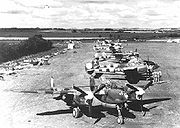 (Image: P-38s
of the 370th Fighter Group)
(Image: P-38s
of the 370th Fighter Group)
A little-known role of the P-38 in the European theater was that of fighter-bomber during the invasion of Normandy and the Allied advance across France into Germany. Assigned to the IX Tactical Air Command, the 370th Fighter Group and its P-38s initially flew missions from England, dive-bombing radar installations, enemy armor, troop concentrations, and flak towers. The 370th's group commander Howard F. Nichols and a squadron of his P-38 Lightnings blasted Field Marshal von Kluge's headquarters in July 1944; the group commander himself skipped a 500-pound bomb right through the front door. Later, the 370th operated from Cardonville France, flying ground attack missions hitting gun emplacements, troops, supply dumps, and tanks near St Lo in July and in the Falaise-Argentan area in August 1944. The 370th participated in ground attack missions across Europe until February 1945, when the unit was transitioned to the P-51 Mustang.
In the Mediterranean Theater, Italian pilots started to face P-38s from late 1942 and considered the type a formidable foe even compared to other lethal fighters including the Supermarine Spitfire. A small number of P-38s fell into the hands of German and Italian units and were subsequently tested and used in combat. Regia Aeronautica chief test pilot Lieutenant Colonel Angelo Tondi used a P-38, possibly an "E" variant, that landed in Sardinia due to a navigational error. Tondi claimed at least one B-24, downed on 11 August 1943. The P-38 eventually was acquired by Italy for postwar service.
Overall, the P-38 performed well in the ETO, though the aircraft suffered regular engine failures in the first months of deployment due to overheating. Many of the aircraft's problems were resolved with the introduction of the P-38J; however, by September 1944, all but one of the Lightning groups in the Eighth Air Force had converted to the P-51. The Eighth AF continued to successfully conduct reconnaissance missions using the F-5 variant.
Pacific theater
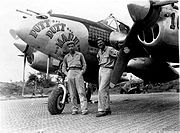 (Image:
Col. MacDonald and Al Nelson in the Pacific with MacDonald's P-38J)
(Image:
Col. MacDonald and Al Nelson in the Pacific with MacDonald's P-38J)
The P-38 was used most extensively and successfully in the Pacific theater, where it proved ideally suited, combining excellent performance with very long range. The P-38 was used in a variety of roles, especially escorting bombers at altitudes between 18-25,000ft. The P-38 was credited with destroying more Japanese aircraft than any other USAAF fighter. Freezing cockpits were not a problem at low altitude in the tropics. In fact, since there was no way to open a window while in flight as it caused buffeting by setting up turbulence through the tailplane, it was often too hot; pilots taking low altitude assignments would often fly stripped down to shorts, tennis shoes, and parachute. While the P-38 could not out-maneuver the Mitsubishi Zero and most other Japanese fighters, its speed and rate of climb gave American pilots the option of choosing to fight or run, and its focused firepower was even more deadly to lightly-armored Japanese warplanes than to the Germans'. The concentrated, parallel stream of bullets allowed aerial victory at much longer distances than fighters carrying wing guns. It is therefore ironic that Dick Bong, the United States' highest scoring World War II air ace (40 victories solely in P-38s), would fly directly at his targets to make sure he hit them (as he himself acknowledged his poor shooting ability), in some cases flying through the debris of his target (and on one occasion colliding with an enemy aircraft which was claimed as a "probable" victory). The twin Allison engines performed admirably in the Pacific.
On 2-4 March 1943, P-38s flew top cover for Fifth Air Force and Australian bombers and attack-planes during the Battle of the Bismarck Sea, a crushing defeat for the Japanese. Two P-38 aces from the 39th Fighter Squadron were killed on the second day of the battle: Bob Faurot and Hoyt "Curley" Eason (a veteran with five victories who had trained hundreds of pilots, including Dick Bong).
General George C. Kenney, commander of the USAAF Fifth Air Force operating in New Guinea, could not get enough P-38s, though since they were replacing serviceable but inadequate P-39s and P-40s, this might seem like guarded praise. Lightning pilots began to compete in racking up scores against Japanese aircraft.
Isoroku Yamamoto
The Lightning figured in one of the most significant operations in the Pacific theater: the interception, on 18 April 1943, of Admiral Isoroku Yamamoto, the architect of Japan's naval strategy in the Pacific including the attack on Pearl Harbor. When American codebreakers found out that he was flying to Bougainville Island to conduct a front-line inspection, 16 P-38G Lightnings were sent on a long-range fighter-intercept mission, flying 435 mi (700 km) from Guadalcanal at heights from 10-50 ft (3-15 m) above the ocean to avoid detection. The Lightnings met Yamamoto's two Mitsubishi G4M "Betty" fast bomber transports and six escorting Zeros just as they arrived. The first Betty crashed in the jungle and the second ditched near the coast. Two Zeros were also claimed by the American fighters with the loss of one P-38. Japanese searchers found Yamamoto's body at the jungle crash site the next day.
Service record
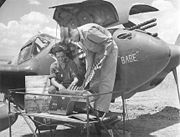 (Image:
Pilot and aircraft armorer inspect ammunition for the central 20 mm cannon)
(Image:
Pilot and aircraft armorer inspect ammunition for the central 20 mm cannon)
The P-38's service record shows mixed results, but usually because of misinformation. P-38s have been described as being harder to fly than single-engined planes, but this was because of inadequate training in the first few months of the war. The P-38's engine troubles at high altitudes only occurred with the Eighth Air Force. One reason for this was the inadequate cooling systems of the G and H models; the improved P-38 J and L had tremendous success flying out of Italy into Germany at all altitudes. Up until the -J-25 variant, P-38s were easily avoided by German fighters because of the lack of dive flaps to counter compressibility in dives. German fighter pilots not wishing to fight would perform the first half of a Split S and continue into steep dives because they knew the Lightnings would be reluctant to follow.
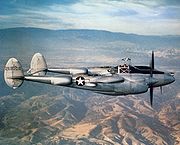 (Image:
P-38J-10-LO, 42-68008, flying over Southern California)
(Image:
P-38J-10-LO, 42-68008, flying over Southern California)
On the positive side, having two engines was a built-in insurance policy. Many pilots made it safely back to base after having an engine fail en route or in combat. On March 3, 1944, the first Allied fighters reached Berlin on a frustrated escort mission. Lt. Col. Jack Jenkins of 55FG led the group of P-38H pilots, arriving with only half his force after flak damage and engine trouble took their toll. On the way in to Berlin, Jenkins reported one rough-running engine and one good one, causing him to wonder if he'd ever make it back. The B-17s he was supposed to escort never showed up, having turned back at Hamburg. Jenkins and his wingman were able to drop tanks and outrun enemy fighters to return home with three good engines between them.
In the European Theatre of Operations (ETO), P-38s made 130,000 sorties with a loss of 1.3% overall, comparing favorably with ETO P-51s which posted a 1.1% loss, considering that the P-38s were vastly outnumbered and suffered from poorly thought-out tactics. The majority of the P-38 sorties were made in the period prior to Allied air superiority in Europe when pilots fought against a very determined and skilled enemy. Lt. Colonel Mark Hubbard, a vocal critic of the aircraft, rated it third best Allied fighter in Europe. The Lightning's greatest virtues were long range, heavy payload, high speed, fast climb, and concentrated firepower. The P-38 was a formidable interceptor and attack aircraft and, in the hands of any pilot, dangerous in air-to-air combat.
In the Pacific theater, the P-38 downed over 1,800 Japanese aircraft, with more than 100 pilots becoming aces by downing five or more enemy. American fuel supplies contributed to a better engine performance and maintenance record, and range was increased with leaner mixtures. In the second half of 1944, the P-38L pilots out of Dutch New Guinea were flying 950 miles (1,530 km), fighting for 15 minutes and returning to base. Such long legs were invaluable until the P-47N and P-51D entered service.
Postwar operations
The end of the war left the USAAF with thousands of P-38s rendered obsolete by the jet age. One hundred late-model P-38L and F-5 Lightnings were acquired by Italy through an agreement dated April 1946. Delivered, after refurbishing, at the rate of one per month, they finally were all sent to the AMI by 1952. The Lightnings served in 4 Stormo and other units including 3 Stormo, flying reconnaissance over the Balkans, ground attack, naval cooperation and air superiority missions. Due to unfamiliarity in operating heavy fighters, old engines, and pilot errors, a large number of P-38s were lost in at least 30 accidents, many of them fatal. Despite this, many Italian pilots liked the P-38 because of its excellent visibility on the ground and stability at takeoff. The Italian P-38s were phased out in 1956; none survived the inevitable scrapyard.
Surplus P-38s were also used by other foreign air forces with a dozen sold to Honduras and fifteen retained by China. Six F-5s and two unarmed black two-seater P-38s were operated by PRD forces based in Cuba in 1947. The majority of wartime Lightnings present in the continental U.S. at the end of the war were put up for sale for US$1,200 apiece; the rest were scrapped. P-38s in distant theaters of war were bulldozed into piles and abandoned or scrapped; very few avoided that fate.
Lockheed test pilot Tony LeVier was among those who bought a Lightning, choosing a P-38J model and painting it red to make it stand out as an air racer and stunt flyer. Lefty Gardner, former B-24 and B-17 pilot and associate of the Confederate Air Force, bought a mid-1944 P-38L-1-LO that had been modified into an F-5G. Gardner painted it white with red and blue trim and named it White Lightnin'; he reworked its turbo systems and intercoolers for optimum low-altitude performance and gave it P-38F style air intakes for better streamlining. P-38s were popular contenders in the air races from 1946 through 1949, with brightly colored Lightnings making screaming turns around the pylons at Reno and Cleveland.
F-5s were bought by aerial survey companies and employed for mapping. From the 1950s on, the use of the Lightning steadily declined, and only a little more than two dozen still exist, with few still flying. One example is a P-38L owned by the Lone Star Flight Museum in Galveston, Texas, painted in the colors of Charles MacDonald's Putt Putt Maru. Two other examples are F-5Gs which were owned and operated by Kargl Aerial Surveys in 1946, and are now located in Chino, California at Yanks Air Museum, and in McMinnville, Oregon at Evergreen Aviation Museum.
Variants
Over 10,000 Lightnings were manufactured in all; becoming the only U.S. combat aircraft that remained in continuous production throughout the duration of American participation in World War II. The Lightning had a major effect on other aircraft; its wing, in a scaled-up form, was used on the L-049 Constellation.
Lightning variants began with the D model. There were no Bs or Cs as the USAAF allocated the 'D' suffix to all aircraft with self-sealing fuel tanks and armor. The first combat-capable Lightning was the P-38E. The P-38E featured improved instruments, and electrical and hydraulic systems. Part-way through production, the older Hamilton Standard Hydromatic hollow steel propellers were replaced by new Curtiss Electric duraluminum propellers. The definitive armament configuration was settled upon, featuring four .50 caliber (12.7 mm) machine guns with 500 rounds per gun, and a Hispano 20 mm cannon with 150 rounds which replaced the unreliable Oldsmobile 37 mm cannon that had been tested on the P-38D.
While the machine guns had been arranged symmetrically in the nose on the P-38D, they were "staggered" in the P-38E and later versions, with the muzzles protruding from the nose in the relative lengths of roughly 1:4:6:2. This was done to ensure a straight ammunition-belt feed into the weapons, as the earlier arrangement led to jamming.
The first P-38E rolled out of the factory in October 1941. Over a hundred P-38Es were completed in the factory or converted in the field to a photo-reconnaissance variant, the F-4, in which the guns were replaced by four cameras. Most of these early reconnaissance Lightnings were retained stateside for training, but the F-4 was the first Lightning to be used in action in April 1942.
After 210 P-38Es were built, they were followed, starting in April 1942, by the P-38F, which incorporated racks inboard of the engines for fuel tanks or a total of 2,000 pounds (900 kg) of bombs. The P-38F was heavier, with more powerful engines that used more fuel. Without external fuel tanks, the range was reduced. General Spaatz, then commander of the Eighth Air Force in the UK, said of the P-38F: "I'd rather have an airplane that goes like hell and has a few things wrong with it, than one that won't go like hell and has a few things wrong with it." A total of 527 P-38Fs were built.
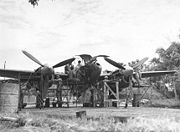 Image:
Ground crew members of the 459th Fighter Squadron, nicknamed the "Twin Dragon Squadron", working on a Lockheed P-38 at an air base in
Chittagong, India - January 1945)
Image:
Ground crew members of the 459th Fighter Squadron, nicknamed the "Twin Dragon Squadron", working on a Lockheed P-38 at an air base in
Chittagong, India - January 1945)
The P-38F was followed in early 1943 by the P-38G, utilizing more powerful Allisons of 1,400 hp (1,040 kW) each and equipped with a better radio. The P-38G was followed in turn by the P-38H, with further uprated Allisons (1,425 hp [1,060 kW] each), an improved 20 mm cannon and a bomb capacity of 3,200 pounds (1,450 kg). These models were also field-modified into F-4A and F-5A reconnaissance aircraft. An F-5A was modified to an experimental two-seat reconnaissance configuration, with additional cameras in the tail booms. Both the P-38G and P-38H models' performance was restricted by an intercooler system integral to the wing's leading edge; one which had been designed for smaller engines. Most ground crews removed this in order to get more power at lower altitudes where the danger of oveheating was reasonably low. The new engines could heat up too much and were subject to explosive detonation in the carburetor if operated beyond recommended limits.
Early variants did not enjoy a high reputation for maneuverability, though they could be agile at low altitudes if flown by a capable pilot, using the P-38's forgiving stall characteristics to their best advantage. From the P-38F-15 model onwards, a "combat maneuver" setting was added to the P-38's Fowler flaps. When deployed at the eight-degree maneuver setting, the flaps allowed the P-38 to out-turn many contemporary single-engined fighters at the cost of some added drag. However, early variants were hampered by high aileron control forces and a low initial rate of roll.
Lightning in maturity: P-38J, P-38L
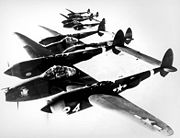 (Image:
Four P-38s flying in formation)
(Image:
Four P-38s flying in formation)
The definitive P-38J was introduced in August 1943. The turbocharger intercooler system on previous variants had been housed in the leading edges of the wings and had proven vulnerable to combat damage and could explode if the wrong series of controls were mistakenly activated. In the P-38J model, the streamlined engine nacelles of previous Lightnings were changed to fit the intercooler radiator between the oil coolers, forming a "chin" that visually distinguished the J model from its predecessors. While the P-38J used the same V-1710-89/91 engines as the H model, the new core-type intercooler more efficiently lowered intake manifold temperatures and permitted a substantial increase in rated power. The leading edge of the outer wing was fitted with 55-gallon fuel tanks, filling the space formerly occupied by intercooler tunnels.
The final 210 J models, designated P-38J-25-LO, alleviated the compressibility problem through the addition of a set of electrically-actuated dive recovery flaps just outboard of the engines on the bottom centerline of the wings. With these improvements, a USAAF pilot reported a dive speed of almost 600 miles per hour (970 km/h), although the indicated air speed was later corrected for compressibility error, and the actual dive speed was lower.
The P-38J-25-LO production block also introduced hydraulically-boosted ailerons, one of the first times such a system was fitted to a fighter. This significantly improved the Lightning's rate of roll and reduced control forces for the pilot. With a truly satisfactory Lightning in place, Lockheed ramped up production, working with subcontractors across the country to produce hundreds of Lightnings each month.
There were two P-38Ks developed in 1942–1943, one official and one an internal Lockheed experiment. The first was a battered RP-38E test mule fitted with paddle-bladed "high activity" Hamilton Standard Hydromatic propellers similar to those used on the P-47. The new propellers required spinners of greater diameter, and the thrust line was slightly higher. New cowlings were fashioned to properly blend the spinners into the nacelles. The aircraft also received the chin intercoolers developed for the P-38J.
The first prototype's performance led to an official request for the second aircraft, a modified P-38G-10-LO (re-designated P-38K-1-LO) fitted with the aforementioned four-blade propellers and new Allison V-1710-75/77 (F15R/L) powerplants rated at 1,875 bhp (1,398 kW) at War Emergency Power. The AAF took delivery in September, 1943, at Eglin Field. In tests, the P-38K-1 achieved 432 mph (695 km/h) at military power and was predicted to exceed 450 mph (720 km/h) at War Emergency Power with a similar increase in load and range. The initial climb rate was 4,800 feet (1,500 m) per minute and the ceiling was 46,000 feet (14,000 m). It reached 20,000 feet (6,100 m) in five minutes flat; this with a coat of camouflage paint which added weight and drag. However, the War Production Board refused to authorize P-38K production due to the two- to three-week interruption in production necessary to implement cowling modifications for the revised spinners and higher thrust line. Some doubted Allison's ability to deliver the F15 engine in quantity. As promising as it had looked, the P-38K project came to a halt.
The P-38L was the most numerous variant of the Lightning, with 3,923 built, 113 by Consolidated-Vultee in their Nashville plant. It entered service with the USAAF in June 1944, in time to support the Allied invasion of France on D-Day. Lockheed production of the Lightning was distinguished by a suffix consisting of a production block number followed by "LO," for example "P-38L-1-LO", while Consolidated-Vultee production was distinguished by a block number followed by "VN," for example "P-38L-5-VN."
The P-38L was the first Lightning fitted with zero-length rocket launchers. Seven HVARs (high velocity aircraft rockets) on pylons beneath each wing, and later, ten rockets on each wing on "Christmas tree" launch racks. The P-38L also had strengthened stores pylons to allow carriage of 2,000 pound (900 kg) bombs or 300 US gallon (1,140 liter) drop tanks.
Lockheed modified 200 P-38J airframes in production to become unarmed F-5B photo-reconnaissance aircraft, while hundreds of other P-38Js and P-38Ls were field-modified to become F-5Es, F-5Fs, and F-5Gs. A few P-38Ls were field-modified to become two-seat TP-38L familiarization trainers.
Late model Lightnings were delivered unpainted, as per USAAF policy established in 1944. At first, field units tried to paint them, since pilots worried about being too visible to the enemy, but it turned out the reduction in weight and drag was a minor advantage in combat.
The P-38L-5, the most common sub-variant of the P-38L, had a modified cockpit heating system which consisted of a plug-socket in the cockpit into which the pilot could plug his heat-suit wire for improved comfort. These Lightnings also received the uprated V-1710-111/113 (F30R/L) engines, and this dramatically lowered the amount of engine failure problems experienced at high altitude so commonly associated with European operations.
Pathfinders, Night Fighter and other variants
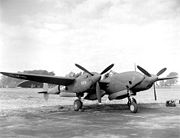 (Image:
F-5A Lightning of the 7th Photo Group, 8th Army Air Force based at Mt. Farm. Note the national insignia is bordered in red with overall finish
in synthetic haze)
(Image:
F-5A Lightning of the 7th Photo Group, 8th Army Air Force based at Mt. Farm. Note the national insignia is bordered in red with overall finish
in synthetic haze)
The Lightning was modified for other roles. In addition to the F-4 and F-5 reconnaissance variants, a number of P-38Js and P-38Ls were field-modified as formation bombing "pathfinders" or "droopsnoots", fitted with a glazed nose with a Norden bombsight, or a H2X radar "bombing through overcast" nose. A pathfinder would lead a formation of other P-38s, each overloaded with two 2,000 lb (907 kg) bombs; the entire formation releasing when the pathfinder did.
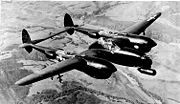 (Image:
Lockheed Model 422 P-38M-6-LO Night Lightning (44-27234, c/n 422-8238))
(Image:
Lockheed Model 422 P-38M-6-LO Night Lightning (44-27234, c/n 422-8238))
A number of Lightnings were modified as night fighters. There were several field or experimental modifications with different equipment fits that finally led to the "formal" P-38M night fighter, or Night Lightning. Seventy-five P-38Ls were modified to the Night Lightning configuration, painted flat-black with conical flash hiders on the guns, an AN/APS-6 radar pod below the nose, and a second cockpit with a raised canopy behind the pilot's canopy for the radar operator. The headroom in the rear cockpit was limited, requiring radar operators who were preferably short in stature.
The additional external clutter imposed surprisingly little penalty on the P-38M's performance, and it remained faster than the purpose-built Northrop P-61 Black Widow night fighter. The Night Lightnings saw some combat duty in the Pacific towards the end of the war, but, verifiably, none engaged in combat.
One of the initial production P-38s had its turbochargers removed, with a secondary cockpit placed in one of the booms to examine how flightcrew would respond to such an "asymmetric" cockpit layout. One P-38E was fitted with an extended central nacelle to accommodate a tandem-seat cockpit with dual controls, and was later fitted with a laminar flow wing.
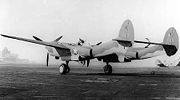 (Image:
Proposed floatplane P-38E testbed, 41-1986, c/n 222-5204, shown with second version of upswept tail designed to keep tail out of water upon takeoff)
(Image:
Proposed floatplane P-38E testbed, 41-1986, c/n 222-5204, shown with second version of upswept tail designed to keep tail out of water upon takeoff)
Very early in the Pacific War, a scheme was proposed to fit Lightnings with floats to allow them to make long-range ferry flights. The floats would be removed before the aircraft went into combat. There were concerns that salt spray would corrode the tailplane, and so in March 1942, P-38E c/n 5204 was modified with a tailplane raised some 16-18 inches, booms lengthened by two feet and a rearward-facing second seat added for an observer to monitor the effectiveness of the new arrangement. A second version was crafted on the same airframe with the twin booms given greater sideplane area to augment the vertical rudders. This arrangement was removed and a final third version was fabricated that had the booms returned to normal length but the tail raised 33 inches. All three tail modifications were designed by George H. "Bert" Estabrook. The final version was used for a quick series of dive tests on December 7, 1942 in which Milo Burcham performed the test maneuvers and Kelly Johnson observed from the rear seat. Johnson concluded that the raised floatplane tail gave no advantage in solving the problem of compressibility. At no time was this P-38E testbed airframe actually fitted with floats, and the idea was quickly abandoned as the U.S. Navy proved to have enough sealift capacity to keep up with P-38 deliveries to the South Pacific.
Still another P-38E was used in 1942 to tow a Waco troop glider as a demonstration. However, there proved to be plenty of other aircraft, such as C-47s, available to tow gliders, and the Lightning was spared this duty.
Standard Lightnings were even used as crew and cargo transports in the South Pacific. They were fitted with pods attached to the underwing pylons, replacing drop tanks or bombs, that could carry a single passenger in a lying-down position, or cargo. This was a very uncomfortable way to fly. Some of the pods weren't even fitted with a window to let the passenger see out or bring in light, and one fellow who hitched a lift on a P-38 in one of these pods later said that "whoever designed the damn thing should have been forced to ride in it."
Lockheed proposed a carrier-based Model 822 version of the Lightning for the United States Navy. The Model 822 would have featured folding wings, an arresting hook, and stronger undercarriage for carrier operations. The Navy was not interested, as they regarded the Lightning as too big for carrier operations and did not like liquid-cooled engines anyway, and the Model 822 never went beyond the paper stage. However, the Navy did operate four land-based F-5Bs in North Africa, inherited from the USAAF and redesignated FO-1.
A P-38J was used in experiments with an unusual scheme for mid-air refueling, in which the fighter snagged a drop tank trailed on a cable from a bomber. The USAAF managed to make this work, but decided it was not practical. A P-38J was also fitted with experimental retractable snow ski landing gear, but this idea never reached operational service either.
After the war, a P-38L was experimentally fitted with armament of three .60 in (15.2 mm) machine guns. The .60 caliber cartridge had been developed early in the war for an infantry "anti-tank rifle", a type of weapon developed by a number of nations in the 1930s when tanks were lighter but, by 1942, the idea of taking on a tank with a large-caliber rifle was considered to be somewhere between "outdated" and "suicidal".
The cartridge was not abandoned, with the Americans designing a derivative of the German MG 151 15 mm aircraft automatic cannon around it and designating the weapon the "T17", but though 300 of these guns were built and over six million .60 caliber rounds were manufactured, they never worked out all the bugs, and the T17 never saw operational service. The cartridge was "necked up" to fit 20 mm projectiles and became a standard U.S. ammunition after the war. The T17-armed P-38L did not go beyond unsuccessful trials.
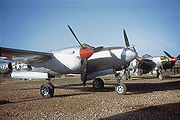 (Image:
P-38s of 449th Fighter Squadron, Chengkung, 1945)
(Image:
P-38s of 449th Fighter Squadron, Chengkung, 1945)
Another P-38L was modified after the war as a "super strafer," with eight .50 in (12.7 mm) machine guns in the nose and a pod under each wing with two .50 in guns, for a total of 12 machine guns. Nothing came of this conversion, either.
A P-38L was modified by Hindustan Aeronautics in India as a fast VIP transport, with a comfortable seat in the nose, leather-lined walls, accommodations for refreshments and a glazed nose to give the passenger a spectacular view.
Noted P-38s
YIPPEE
(Image:
P-38J Lightning YIPPEE)
The 5,000th Lightning built, a P-38J-20-LO, 44-23296, was painted bright vermilion red, and had the name YIPPEE painted on the underside of the wings in big white letters as well as the signatures of hundreds of factory workers. This aircraft was used by Lockheed test pilots Milo Burcham and Tony LeVier in remarkable flight demonstrations, performing such stunts as slow rolls at treetop level with one prop feathered to show that the P-38 was not the unmanageable beast of legend. Their exploits did much to reassure pilots that the Lightning might be a handful, but it was by no means a "widow maker."
Noted P-38 pilots
Richard Bong and Thomas McGuire
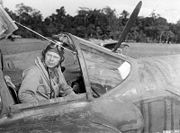 (Image:
Major Richard Bong in his P-38)
(Image:
Major Richard Bong in his P-38)
The American ace of aces and his closest competitor both flew Lightnings as they tallied 40 and 38 victories each. Majors Richard I. "Dick" Bong and Thomas J. "Tommy" McGuire of the USAAF competed for the top position, a rivalry made interesting by the contrast in personalities of the two men. Both Bong and McGuire were very aggressive and fearless in the air. After dogfights, their P-38s would be warped out of shape by overstress. On the ground, they were completely different men. Dick Bong was a modest, quiet, almost shy man, while the egotistical McGuire was "an unpleasant individual with a talent much bigger than he was," as one of his colleagues remembered him.
Bong was rotated back to the States as America's ace of aces, after making 40 kills. He was killed on 6 August 1945, the day the atomic bomb was dropped on Japan, when his P-80 Shooting Star jet fighter flamed out on takeoff. McGuire had been killed in air combat in January 1945 over the Philippines, after racking up 38 confirmed kills, making him the second-ranking American ace. Both men were awarded the Medal of Honor.
Charles Lindbergh
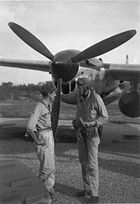 (Image:
(L-R) Thomas B. McGuire and Charles Lindbergh discussing a mission on Bial Island in July 1944)
(Image:
(L-R) Thomas B. McGuire and Charles Lindbergh discussing a mission on Bial Island in July 1944)
The famed aviator Charles Lindbergh toured the South Pacific as a civilian contractor for United Aircraft Corporation, comparing and evaluating performance of single- and twin-engined fighters for Vought. He worked to improve range and load limits of the F4U Corsair, flying both routine and combat strafing missions in Corsairs alongside Marine pilots. In Hollandia, he attached himself to the 475th FG flying P-38s so that he could investigate the twin-engine fighter. Though new to the machine, he was instrumental in extending the range of the P-38 through improved throttle settings, or engine-leaning techniques, notably by reducing engine speed to 1600 rpm, setting the carburetors for auto-lean and flying at 185 mph (298 km/h) indicated airspeed which reduced fuel consumption to 70 gallons an hour, about 2.6 mpg. This combination of settings had been considered dangerous; it was thought it would upset the fuel mixture and cause an explosion. Everywhere Lindbergh went in the South Pacific, he was accorded the normal preferential treatment of a visiting colonel, though he had resigned his Air Corps Reserve colonel's commission three years before. While with the 475th, he held training classes and took part in a number of Army Air Corps combat missions. On 28 July 1944 Lindbergh shot down a Mitsubishi Ki-51 Sonia flown expertly by the veteran commander of 73rd Independent Flying Chutai, Imperial Japanese Army Captain Saburo Shimada. In an extended, twisting dogfight in which many of the participants ran out of ammunition, Shimada turned his aircraft directly toward Lindbergh who was just approaching the combat area. Lindbergh fired in a defensive reaction brought on by Shimada's apparent head-on ramming attack. Hit by cannon and machine gun fire, the Sonia's propeller visibly slowed, but Shimada held his course. Lindbergh pulled up at the last moment to avoid collision as the damaged Sonia went into a steep dive, hit the ocean and sank. Lindbergh's wingman, ace Joseph E. "Fishkiller" Miller, Jr., had also scored hits on the Sonia after it had begun its fatal dive, but Miller was certain the kill credit was Lindbergh's. The unofficial kill was not entered in the 475th's war record. On 12 August 1944 Lindbergh left Hollandia to return to the States.
Charles MacDonald
The seventh-ranking American ace, Charles H. MacDonald, also flew a Lightning against the Japanese, scoring 27 kills in his famous aircraft, the Putt Putt Maru.
Clay Tice
A P-38 piloted by Clay Tice was the first American aircraft to land in Japan after VJ-Day, when he and his wingman set down on Nitagahara because his wingman was low on fuel.
Antoine de Saint-Exupery
Noted aviation pioneer and writer Antoine de Saint-Exupery vanished in a F-5B-1-LO, 42-68223, c/n 2734, of II/33 Squadron, out of Borgo-Porreta, Bastia, Corsica, a reconnaissance variant of the P-38, while on a flight over the Mediterranean, from Corsica to mainland France, on 31 July 1944. His health, both physical and mental (he was said to be intermittently subject to depression), had been deteriorating and there had been talk of taking him off flight status. There have been suggestions (although no proof to date) that this was a suicide rather than an aircraft failure or combat loss. In 2000, a French scuba diver found the wreckage of a Lightning in the Mediterranean off the coast of Marseille, and it was confirmed in April 2004 as Saint-Exupery's F-5B. No evidence of air combat was found. In March 2008 a former Luftwaffe pilot, Horst Rippert from Jagdgruppe 200, claimed his shooting down.
Adrian Warburton
The RAF's legendary photo-recon "ace", Wing Commander Adrian Warburton DSO DFC, was the pilot of a Lockheed P-38 borrowed from the USAAF that took off on 12 April 1944 to photograph targets in Germany. W/C Warburton failed to arrive at the rendezvous point and was never seen again. In 2003, his remains were recovered in Germany from his wrecked USAAF P-38 Lightning.
Specifications (P-38L)
General characteristics
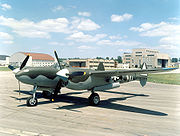 (Image:
Lockheed P-38L Lightning at the National Museum of the United States Air Force, marked as a P-38J of the 55th Fighter Squadron, based in England)
(Image:
Lockheed P-38L Lightning at the National Museum of the United States Air Force, marked as a P-38J of the 55th Fighter Squadron, based in England)
Crew:
One
Length: 37 ft 10 in (11.53 m)
Wingspan: 52 ft 0 in (15.85 m)
Height: 9 ft 10 in (3.00 m)
Wing area: 327.5 ft² (30.43 m²)
Airfoil: NACA 23016 / NACA 4412
Empty weight: 12,780 lb (5,800 kg)
Loaded weight: 17,500 lb (7,940 kg)
Max takeoff weight: 21,600 lb (9,798 kg)
Powerplant: 2× Allison V-1710-111/113 liquid-cooled turbosupercharged V-12, 1,725 hp (As certified by Lockheed and Allison Industries) (1,194 kW) each
Zero-lift drag coefficient: 0.0268
Drag area: 8.78 ft² (0.82 m²)
Aspect ratio: 8.26
Performance
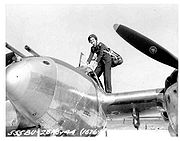 (Image: Ruth
Dailey, WASP climbs into a P-38)
(Image: Ruth
Dailey, WASP climbs into a P-38)
Maximum speed: 443mph War Emergency Power-1725 hp@64inHG(28,000ft)
Stall speed: 105 mph (170 km/h)
Range: 1,300 mi combat, over 3,300 mi (5,300 km) ferry (1,770 km / 3,640 km)
Service ceiling 44,000 ft (13,400 m)
Rate of climb: maximum: 4,750 ft/min (1,448 m/min)
Wing loading: 53.4 lb/ft² (260.9 kg/m²)
Power/mass: 0.16 hp/lb (0.27 kW/kg)
Turn Radius: At Eglin Field in 1942, the P-38 was said to have an "equal or tighter radius of turn from 15,000 ft (4,600 m) on up" against the P-51, P-40, P-47 and other aircraft. The tests were conducted with the engine power restricted, which means the P-38F that was tested was probably a bit more maneuverable. Further versions of the P-38 were even more agile, especially the P-38L. (The rate of roll was also found too slow at high speeds and medium at low speeds.)
Lift-to-drag ratio: 13.5
Armament
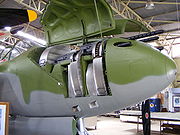 (Image:
M2 machine gun armament in the nose of the P-38)
(Image:
M2 machine gun armament in the nose of the P-38)
1× Hispano
M2(C) 20 mm cannon with 150 rounds (2 AP, 2 tracer and 2 HE ammo belt composition) and 4× Colt-Browning MG53-2 0.50 in (12.7 mm) machine
guns with 500 rounds per gun. The rate of fire was about 650 rounds per minute for the 20×110 mm cannon round (130 g shell) at a muzzle velocity
of about 2887 ft/s, and for the .50 in MGs (43–48 g), about 850 rpm at 2756 ft/s velocity.
4× M10 three-tube 4.5 in (112 mm) rocket launchers or:
Inner Hardpoints: 2× 2,000 lb (907 kg) bombs or drop tanks; or 2× 1,000 lb (454 kg) bombs or drop tanks, plus either 4× 500 lb (227 kg) or 4× 250 lb (113 kg) bombs; or 6× 500 lb (227 kg) or 6× 250 lb (113 kg) bombs
Outer Hardpoints: 10× 5 in (127 mm) HVARs (High Velocity Aircraft Rocket); or 2× 500 lb (227 kg) or 2× 250 lb (113 kg) bombs
Popular culture
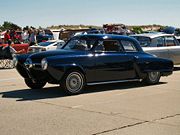 (Image: 1950
Studebaker Champion)
(Image: 1950
Studebaker Champion)
The Lockheed P-38 was inspiration for Raymond Loewy and his design team at Studebaker for the 1950 and 1951 model years.
The Lockheed P-38 has been the "star" of a number of contemporary movies including:
A Guy Named Joe (1943) has Spencer Tracy returning as a guiding spirit looking after young P-38 pilot Van Johnson.
Flight Characteristics of the Lockheed P-38 Lightning (1943, color, 34:00). Lockheed's top World War II test pilots do the checkout on this very thorough pilot training film.
Yamamoto shot down! (1944, B&W, 4:00) The P-38 Squadron that shot down Admiral Yamamoto in an incredible long distance interception in the Pacific, is depicted. The film includes purported P-38 gun camera footage of the Admiral's Betty bomber going down in flames.
Dick Bong: Pacific Ace (1944, B&W, 4:00) This short documentary film pays tribute to Richard "Dick" Bong, the leading American P-38 ace of World War II.
P-38 Reconnaissance Pilot (1944, B&W, 29:00) Starring William Holden as Lt. "Packy" Cummings, this short feature shows that photo recon pilots (photo Joes) had one of the riskiest, highest impact jobs in the war.
Angel in Overalls (1945, B&W, 15:00) This film was developed to show US Lockheed P-38 production line workers in a wide variety of roles.
Scaled Composites Pond Racer (1991-1993), built by Burt Rutan, echoed the design of the P-38 in a radical way.
Source: WikiPedia